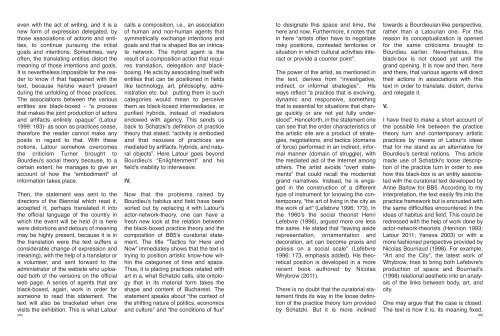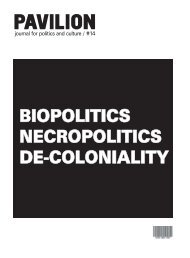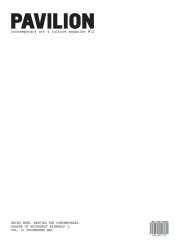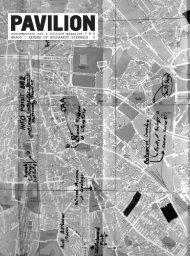Download pdf version of issue no. 16 (4 Mb) - Pavilion
Download pdf version of issue no. 16 (4 Mb) - Pavilion
Download pdf version of issue no. 16 (4 Mb) - Pavilion
Create successful ePaper yourself
Turn your PDF publications into a flip-book with our unique Google optimized e-Paper software.
even with the act <strong>of</strong> writing, and it is a<br />
new form <strong>of</strong> expression delegated, by<br />
those associations <strong>of</strong> actions and entities,<br />
to continue pursuing the initial<br />
goals and intentions. Sometimes, very<br />
<strong>of</strong>ten, the translating entities distort the<br />
meaning <strong>of</strong> those intentions and goals.<br />
It is nevertheless impossible for the reader<br />
to k<strong>no</strong>w if that happened with the<br />
text, because he/she wasn't present<br />
during the unfolding <strong>of</strong> those practices.<br />
The associations between the various<br />
entities are black-boxed - “a process<br />
that makes the joint production <strong>of</strong> actors<br />
and artifacts entirely opaque” (Latour<br />
1999: 183)- as soon as practices cease,<br />
therefore the reader can<strong>no</strong>t make any<br />
posits in regard to that. With these<br />
<strong>no</strong>tions, Latour somehow overcomes<br />
the criticism Turner brought to<br />
Bourdieu's social theory because, to a<br />
certain extent, he manages to give an<br />
account <strong>of</strong> how the “embodiment” <strong>of</strong><br />
information takes place.<br />
Then, the statement was sent to the<br />
directors <strong>of</strong> the Biennial which read it,<br />
accepted it, perhaps translated it into<br />
the <strong>of</strong>ficial language <strong>of</strong> the country in<br />
which the event will be held (it is here<br />
were distortions and detours <strong>of</strong> meaning<br />
may be highly present, because it is in<br />
the translation were the text suffers a<br />
considerable change <strong>of</strong> expression and<br />
meaning), with the help <strong>of</strong> a translator or<br />
a volunteer, and sent forward to the<br />
administrator <strong>of</strong> the website who uploaded<br />
both <strong>of</strong> the <strong>version</strong>s on the <strong>of</strong>ficial<br />
web page. A series <strong>of</strong> agents that are<br />
black-boxed, again, work in order for<br />
someone to read this statement. The<br />
text will also be bracketed when one<br />
visits the exhibition. This is what Latour<br />
[88]<br />
calls a composition, i.e., an association<br />
<strong>of</strong> human and <strong>no</strong>n-human agents that<br />
symmetrically exchange intentions and<br />
goals and that is shaped like an intricate<br />
network. The hybrid agent is the<br />
result <strong>of</strong> a composition action that requires<br />
translation, delegation and blackboxing.<br />
He acts by associating itself with<br />
entities that can be positioned in fields<br />
like tech<strong>no</strong>logy, art, philosophy, administration<br />
etc. but putting them in such<br />
categories would mean to perceive<br />
them as black-boxed intermediaries, or<br />
purified hybrids, instead <strong>of</strong> mediators<br />
endowed with agency. This sends us<br />
back to Schatzki's definition <strong>of</strong> practice<br />
theory that stated: “activity is embodied<br />
and that nexuses <strong>of</strong> practices are<br />
mediated by artifacts, hybrids, and natural<br />
objects”. Here Latour goes beyond<br />
Bourdieu's “Enlightenment” and his<br />
field's inability to interweave.<br />
IV.<br />
Now that the problems raised by<br />
Bourdieu's habitus and field have been<br />
sorted out by replacing it with Latour's<br />
actor-network-theory, one can have a<br />
fresh new look at the relation between<br />
the black-boxed practice theory and the<br />
composition <strong>of</strong> BB5's curatorial statement.<br />
The title “Tactics for Here and<br />
Now” immediately shows that the text is<br />
trying to position artistic k<strong>no</strong>w-how within<br />
the categories <strong>of</strong> time and space.<br />
Thus, it is placing practices related with<br />
art in a, what Schatzki calls, site ontology<br />
that in its material form takes the<br />
shape and content <strong>of</strong> Bucharest. The<br />
statement speaks about “the context <strong>of</strong><br />
the shifting nature <strong>of</strong> politics, eco<strong>no</strong>mics<br />
and culture” and “the conditions <strong>of</strong> flux”<br />
to designate this space and time, the<br />
here and <strong>no</strong>w. Furthermore, it <strong>no</strong>tes that<br />
in here “artists <strong>of</strong>ten have to negotiate<br />
risky positions, contested territories or<br />
situation in which cultural activities interact<br />
or provide a counter point”.<br />
The power <strong>of</strong> the artist, as mentioned in<br />
the text, derives from “investigative,<br />
indirect, or informal strategies”. His<br />
ways reflect “a practice that is evolving,<br />
dynamic and responsive, something<br />
that is essential for situations that change<br />
quickly or are <strong>no</strong>t yet fully understood”.<br />
Henceforth, in the statement one<br />
can see that the order characteristics <strong>of</strong><br />
the artistic site are a product <strong>of</strong> strategies,<br />
negotiations, and tactics (domains<br />
<strong>of</strong> force) performed in an indirect, informal<br />
manner (domain <strong>of</strong> struggle), with<br />
the mediated aid <strong>of</strong> the Internet among<br />
others. The artist avoids “overt statements”<br />
that could recall the modernist<br />
grand narratives. Instead, he is engaged<br />
in the construction <strong>of</strong> a different<br />
type <strong>of</strong> instrument for k<strong>no</strong>wing the contemporary,<br />
“the art <strong>of</strong> living in the city as<br />
the work <strong>of</strong> art” (Lefebvre 1996: 173). In<br />
the 1960's the social theorist Henri<br />
Lefebvre (1996), argued more ore less<br />
the same. He stated that “leaving aside<br />
representation, ornamentation and<br />
decoration, art can become praxis and<br />
poiesis on a social scale” (Lefebvre<br />
1996: 173, emphasis added). His theoretical<br />
position is developed in a more<br />
recent book authored by Nicolas<br />
Whybrow (2011).<br />
There is <strong>no</strong> doubt that the curatorial statement<br />
finds its way in the loose definition<br />
<strong>of</strong> the practice theory turn provided<br />
by Schatzki. But it is more inclined<br />
towards a Bourdieuian-like perspective,<br />
rather than a Latourian one. For this<br />
reason its conceptualization is opened<br />
for the same criticisms brought to<br />
Bourdieu earlier. Nevertheless, this<br />
black-box is <strong>no</strong>t closed yet until the<br />
grand opening. It is <strong>no</strong>w and then, here<br />
and there, that various agents will direct<br />
their actions in associations with this<br />
text in order to translate, distort, derive<br />
and relegate it.<br />
V.<br />
I have tried to make a short account <strong>of</strong><br />
the possible link between the practice<br />
theory turn and contemporary artistic<br />
practices by means <strong>of</strong> Latour's ideas<br />
that for me stand as an alternative for<br />
Bourdieu's central <strong>no</strong>tions. This article<br />
made use <strong>of</strong> Schatzki's loose description<br />
<strong>of</strong> the practice turn in order to see<br />
how this black-box is an entity associated<br />
with the curatorial text developed by<br />
Anne Barlow for BB5. According to my<br />
interpretation, the text easily fits into the<br />
practice framework but is encrusted with<br />
the same difficulties encountered in the<br />
ideas <strong>of</strong> habitus and field. This could be<br />
redressed with the help <strong>of</strong> work done by<br />
actor-network-theorists (Hennion 1993;<br />
Latour 2011; Yaneva 2003) or with a<br />
more fashioned perspective provided by<br />
Nicolas Bourriaud (1998). For example,<br />
“Art and the City”, the latest work <strong>of</strong><br />
Whybrow, tries to bring both Lefebvre's<br />
production <strong>of</strong> space and Bourriad's<br />
(1998) relational aesthetic into an analysis<br />
<strong>of</strong> the links between body, art, and<br />
city.<br />
One may argue that the case is closed.<br />
The text is how it is, its meaning fixed,<br />
[89]








